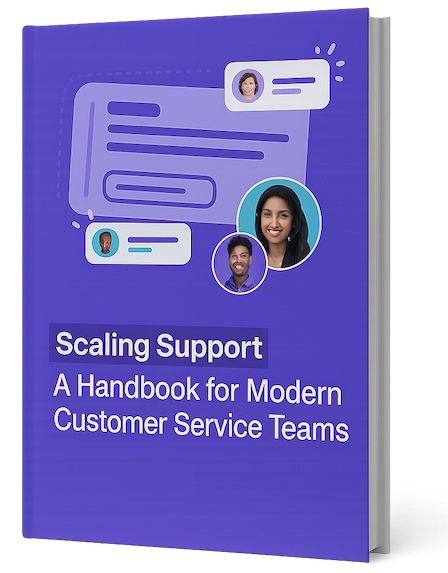When customers are happy, businesses thrive. It’s a simple truth that goes beyond just making people feel good – satisfied customers drive real business growth through repeat purchases, referrals, and long-term loyalty. That’s why measuring and understanding customer satisfaction is crucial for any company looking to succeed.
The Ripple Effect of Satisfied Customers
One satisfied customer can create a powerful chain reaction. When someone has a great experience with your business, they’re likely to tell others, come back for more purchases, and become a loyal advocate for your brand. For example, a customer who receives exceptional service might share their positive experience on social media or directly recommend your company to friends and family. This organic word-of-mouth marketing can bring in new customers at a fraction of the cost of traditional advertising.
Why Traditional Metrics Can Be Misleading
While tools like Customer Satisfaction Scores (CSAT) provide useful data points, they only show part of the picture. These scores typically capture customer sentiment at a single moment, missing the broader context of their relationship with your brand. For instance, a customer might give a low score after one frustrating interaction, even if they’ve had dozens of positive experiences before. That’s why it’s essential to look at multiple metrics and gather qualitative feedback to truly understand customer satisfaction.
The Link Between Service and Satisfaction
The numbers tell a clear story about how service quality affects customer behavior. 93% of customers make repeat purchases from companies offering excellent service. After positive service experiences, 89% of customers return to buy again. Plus, 88% of consumers say online reviews about customer service influence their buying decisions. These findings come from extensive research outlined here: Learn more about the impact of customer service. This data shows why investing in service quality and training pays off through increased customer retention and sales.
Building a Customer-Centric Culture
Creating lasting customer satisfaction starts with building a customer-centric culture throughout your organization. This means every team – from product development to marketing to customer service – must prioritize customer needs in their decisions and actions. When everyone works together toward this goal, it creates positive experiences at every customer touchpoint. Similar to a well-rehearsed orchestra, each department plays its part to create a harmonious customer experience that builds loyalty over time.
Crafting a Customer Service Strategy That Actually Works
Great customer service is about real connection, not following standard playbooks. When you build a strategy that truly considers your unique customers and their specific needs, you create service experiences that leave a lasting positive impression.
Aligning Service Standards With Customer Expectations
The foundation of effective service starts with understanding what your customers want. This means knowing their preferred ways to get help, how fast they expect responses, and what excellent service looks like to them. Then you can create standards that match these expectations while staying realistic about your resources. For example, while 24/7 phone support might be ideal, providing quick responses during business hours plus helpful self-service options often works better for many businesses.
Empowering Your Team for Service Excellence
Your service strategy succeeds through your team’s skills and dedication. Investing in thorough training equips your customer service staff with both essential product knowledge and key interpersonal abilities like active listening and empathy. As they master these skills, your team can handle difficult situations skillfully and build genuine connections with customers. This personal touch helps turn basic service interactions into opportunities for building real loyalty.
Resolving Complaints Quickly and Effectively
Quick complaint resolution directly impacts customer retention. Research shows that 80% of customers will stay with a company that addresses their complaints promptly. Even more impressive, 83% of customers will recommend businesses that turn their complaints into positive experiences. See more data here: Learn more about customer satisfaction research. These numbers highlight why fast, effective complaint handling is vital for keeping customers happy and encouraging word-of-mouth recommendations.
Building a Feedback Loop for Continuous Improvement
Regular customer feedback helps you refine your approach over time. Using surveys, feedback forms and social listening gives you clear insights into what’s working and what needs adjustment. By analyzing this information carefully, you can spot areas for improvement and keep your service aligned with what customers need. Making evaluation and adjustment part of your routine helps maintain high satisfaction levels and strengthen customer relationships over the long term.
Using Technology to Improve Customer Experience

Technology provides excellent tools to boost customer satisfaction, but success depends on smart implementation. The key is using technology to strengthen – not replace – human connections. This means carefully selecting tools that align with your specific needs and avoiding common mistakes that can hurt the customer experience.
AI Solutions for Better Service
AI is changing how companies handle customer support. AI chatbots can now provide 24/7 assistance with common questions, freeing up support agents to focus on more complex issues. This leads to faster response times – a crucial factor in keeping customers happy. AI also analyzes customer data to personalize interactions, from recommending relevant products to adjusting communication style based on past interactions.
Smart Automation for Better Results
The right automation helps your team focus on high-value customer interactions that need a human touch. For example, automating order updates and appointment reminders ensures customers get timely information without taking up staff time. This builds trust through consistent communication while reducing frustration. Tools like SupportMan help by automatically sending customer ratings to Slack, enabling quick responses to feedback.
Making Every Interaction Personal
Good personalization means understanding each customer’s specific needs. Think about your favorite local store where they remember your preferences – that personal touch makes you feel valued. Using customer data smartly lets you tailor product suggestions, offers, and communication style to each person. This creates stronger connections that lead to increased loyalty and satisfaction.
Selecting the Right Tools
When adding new technology, take time to evaluate options carefully. Focus on tools that work well with your current systems and solve real customer needs. Look for solutions that measurably improve key areas like response speed, personalization, or self-service options. Create a clear framework to assess potential tools and their ROI. Remember – only adopt technology that truly makes things better for your customers.
Building a Customer-Obsessed Organization
Creating an organization that puts customers first requires more than good service – it means weaving customer focus into every part of your company culture. This starts with getting every team, from product development to accounting, aligned around delighting customers. The most successful companies achieve this by building systems that naturally encourage customer-centric behaviors.
Breaking Down Silos and Fostering Collaboration
Departmental silos often stand in the way of great customer experiences. When teams operate independently, they can lose sight of the customer’s needs. For instance, marketing might promise fast delivery without checking if operations can handle the volume – leading to disappointed customers. The solution lies in opening up communication channels between departments. Creating cross-functional teams focused on specific customer journeys helps ensure everyone stays coordinated and works toward shared customer-focused goals.
Creating Cross-Functional Customer Advocacy
Customer advocacy needs to extend beyond just the support team – every employee should see themselves as a customer champion. Regular training helps teams understand how their role impacts customer satisfaction. Sharing customer feedback and success stories throughout the company reinforces this mindset. Think of it like a sports team where every player, from starters to coaching staff, contributes to winning (or in this case, customer happiness).
Developing Systems That Reinforce Customer-Centricity
Building customer focus into your organization requires consistent reinforcement. One effective approach is including customer satisfaction metrics in performance reviews at all levels. This creates accountability for customer experience across the entire company. Tools like SupportMan can help by providing real-time feedback and metrics directly to teams within Slack, creating a constant loop of customer insights and improvements. Learn how SupportMan can enhance your team’s performance.
Measuring and Rewarding Customer-Focused Initiatives
Long-term success requires tracking and recognizing customer-focused efforts. While CSAT scores matter, it’s also important to celebrate employees who go above and beyond for customers. Recognition can range from simple thank-yous to formal rewards programs. These celebrations reinforce that customer satisfaction drives business success and show every employee their role in achieving it.
Creating Feedback Systems That Drive Real Change

Customer feedback is essential for business growth, but simply collecting responses isn’t enough. The real value comes from having systems in place that translate customer input into meaningful improvements. This requires both thoughtful methods for gathering insights and clear processes for acting on what you learn.
Gathering Meaningful Insights: Going Beyond the Basics
While basic surveys serve a purpose, getting deeper customer insights requires more sophisticated approaches. For example, AI analysis tools can examine customer reviews and support conversations to spot key themes and emotional patterns. This helps you understand not just what customers say, but how they truly feel about their experience. Well-crafted surveys can also dig into the reasons behind customer satisfaction levels, rather than just tracking scores.
Closing the Loop: From Feedback to Action
The most effective feedback systems create a clear path from customer input to real changes. This means having specific steps for reviewing feedback, identifying problems, making improvements, and measuring results. For instance, if customers report long support wait times, you might add more staff or improve self-service options. You’d then track metrics like resolution speed to confirm these changes actually improved the customer experience.
Maintaining Engagement: Keeping Customers Involved
When you actively ask for and respond to feedback, customers feel valued and connected to your brand. The key is making it simple and convenient for them to share their thoughts. Tools like SupportMan can help by building feedback collection right into communication channels like Slack. Quick responses and genuine appreciation for all feedback, whether positive or negative, show customers their input matters.
Turning Insights into Action: Driving Strategic Decisions
Customer feedback data only becomes valuable when you use it to make smart business choices. This means finding common themes in complaints, spotting behavior patterns, and identifying unmet needs. These insights can guide decisions across your company – from product updates to marketing messages to service improvements. By directly connecting feedback to action, customers help shape every part of your business. When feedback shows demand for new features, your product team can prioritize those updates to better serve customer needs.
Measuring Success Through Customer-Centric Metrics

Getting clear insights into customer satisfaction is essential for business growth. While surveys play a role, the key is understanding which metrics truly show how happy customers are and predict long-term success. Let’s explore how leading companies use data to make real improvements.
Key Metrics for Measuring Customer Satisfaction
Three core metrics help paint the full picture of customer experience:
- Customer Satisfaction Score (CSAT): Measures satisfaction right after specific interactions like purchases or support calls. This helps identify areas for improvement in specific parts of the customer journey.
- Net Promoter Score (NPS): Shows customer loyalty by asking if they’d recommend your business. It’s a good predictor of growth since happy customers tend to refer others.
- Customer Effort Score (CES): Focuses on how easy it is to work with your business. Lower scores mean smoother experiences, while higher ones point to friction points that need fixing.
These metrics work best together. For example, if you see high satisfaction with individual interactions but low overall loyalty scores, it may mean your service is inconsistent.
Building Effective Measurement Systems
Good measurement systems need three key elements:
- Real-time Feedback: Getting feedback right after interactions lets you fix issues quickly. Tools like SupportMan help by sending Intercom ratings directly to Slack for fast response.
- Closed-Loop Process: Have a clear system for reviewing feedback, making changes, and measuring if those changes worked. This creates ongoing improvement.
- Team-wide Visibility: Make customer feedback available across departments so everyone sees how their work affects customers. This builds customer focus throughout the company.
Turning Data into Actionable Insights
Data becomes valuable when you use it to make things better. Look for patterns in feedback to find hidden problems and opportunities. Try breaking down feedback by customer segments or using sentiment analysis to understand the emotions driving behavior. Then use these insights to guide decisions – from product updates to marketing campaigns. Taking action on feedback shows customers you care about their input and helps build stronger relationships.


